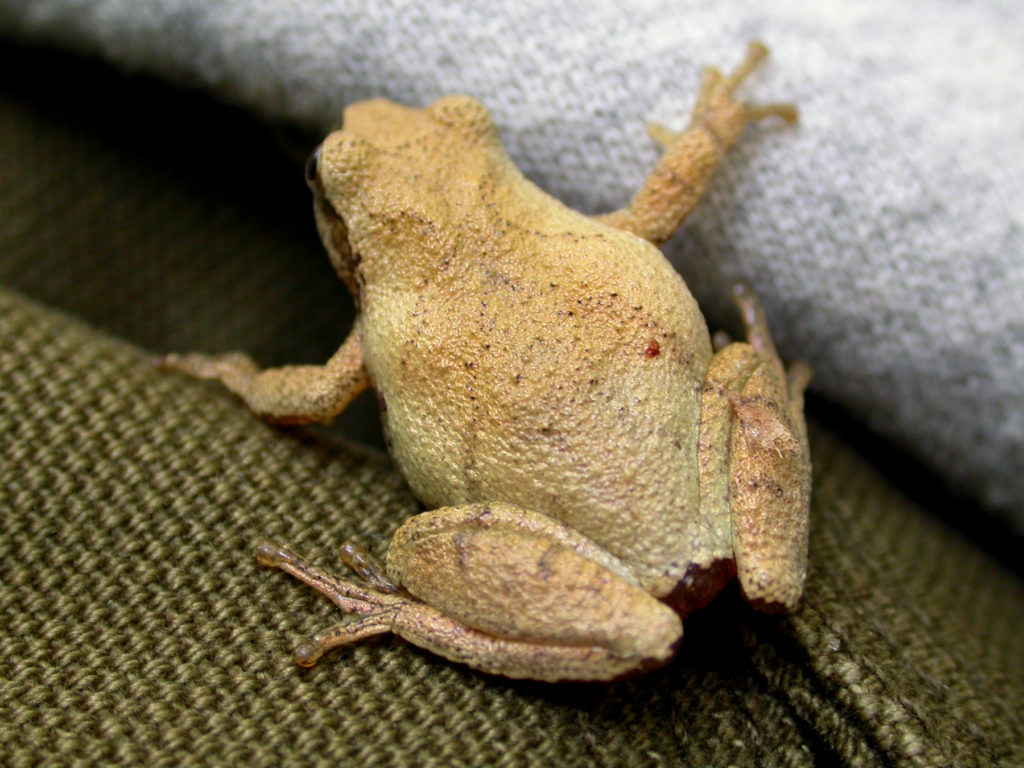Door to Nature: Spring Peepers
- Share
- Tweet
- Pin
- Share

When the temperature finally reaches the 50s and 60s and April’s cold rains are a fading memory, spring finally takes command and there will emanate from the wetlands the sweetest most jubilant “jingle bells” music in this land. The spring peepers will have begun their singing.
If animals are capable of expressing happiness, then each spring finds the frogs and toads rejoicing in song to the tops of their lungs.
Our frequent visits as children to my mom’s uncle Walter and aunt Mandy Barr’s home north of Kewaunee included a memorable introduction to the delightful tinkling songs, off in the distance, of thousands of peepers. A nearby swampy woods, frequently flooded somewhat in spring and later carpeted with cowslips, was the home of these tiny one to one-and-three-eighths-inch long mighty singers.
Marshes, swamps, flooded ditches near woods and ponds are home to these miniature tree frogs having suction cup-like discs on the tips of their toes and an “X” or cross on their back. Hyla crucifer, what a perfect Latin name. They prefer brushy second growth or cutover woods especially if they are near areas that flood every spring.
Water is critical in their reproduction. The smaller males will reach the wet areas first and begin singing to attract females as soon as the air temperature reaches about 52 degrees.
A male northern spring peeper has an enormous vocal sac in proportion to its body size. This rather spherical thin sac resembles a tiny balloon when inflated and helps to add resonance, to carry the shrill “peeps” to the egg-laden females.
Often in the past, while listening to a chorus of spring peepers, I have heard a few that had lovely trills in their songs. Ordinarily the male will utter a peep every second or more, lasting slightly less than one second, for as many as 10 to 30 seconds. The song sounds somewhat like “peEEP – peEEP – peEEP” with each note slurring quickly upward and sung approximately two octaves above middle C. Perhaps we could refer to the peepers as the boy sopranos of the frog world.
Combine the vocal outpouring of several thousand spring peepers and, especially heard from a distance, they become the jingling sleigh bells of spring. Perhaps the sleigh bell quality is achieved because the pitches of these “troubadours” differ slightly from one singer to the next.
Study has revealed that the smallest species of frogs have the shrillest voices, and the frogs that commonly breed in temporary water have the loudest calls. Spring peepers fit this description to a “for-TEE-simo.”

The faint “X” can be seen on this peeper’s back and you can see the broad toe tips which are a bit like suction cups helping it cling to many surfaces. Photo by Roy Lukes.
Usually toward the end of the singing period the females finally make their way to the amorous males that are still peeping to the tops of their lungs. The smaller male will clasp a female tightly around her neck from the back. The larger female will cling to some submerged leaf or stem with her fore limbs.
Now, out of her cloaca comes a single egg, rarely two, that is immediately fertilized by the male. Then the egg is stuck to the supporting object by the female. During the peak of their mating the female may be laying an egg every five seconds. Often it is slower than this and quite frequently the pair floats to the surface of the water to rest, still clinging to one another.
The female, having anywhere from 750 to 1,300 eggs to lay, may continue to deposit these tiny white to cream-colored 1/125th-inch-long eggs for as many as 30 hours. Naturally a continued depth of water is required for the hatching tadpoles, about three-sixteenth inches long and subsisting mainly on diatoms and algae, to develop to the point whereby they can leave the water and live on land. Depending upon various factors this can occur within 60 to 100 days.
For as loud as a chorus of spring peepers is in spring, try to find one adult during the summer! They appear to have vanished into thin air. But they’re widely scattered throughout woodlands and are usually on the ground or close to it in search of food.
Being true tree frogs, their toes are formed such that the tips of the digits can bend backward. There are more than 800 species worldwide but not all live in trees. The uniting feature of these creatures is the end bone of their toes, called the terminal phalanx, which is shaped like a claw. This enables most tree frogs to climb very steep, even vertical slopes. In spite of this ability the spring peepers remain close to terra firma.
Every late summer or early fall I can expect someone to ask me what that unusual shrill peep is off in the distance. “What bird is making that sound?” they will ask. It comes as a surprise to learn that it is a male spring peeper beginning to sing as his sperm ripens and is being stored in his testes ready for early spring mating. In a more joking manner I tell the people that young spring peeper males are receiving singing lessons so, come next spring, they will be ready to join the great chorus.
Shake loose one of these mild early spring evenings, drive out to the quiet countryside near a wooded wetland and thrill to one of nature’s grandest forms of music that has remained unchanged for centuries. Jeepers creepers, will you ever like those peepers!




